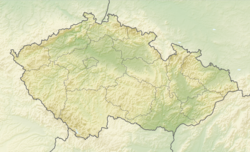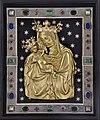Brandýs nad Labem-Stará Boleslav
Brandýs nad Labem-Stará Boleslav | |
|---|---|
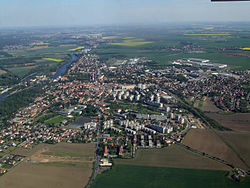 Aerial view of Brandýs nad Labem | |
| Coordinates: 50°11′22″N 14°40′2″E / 50.18944°N 14.66722°E | |
| Country | |
| Region | Central Bohemian |
| District | Prague-East |
| First mentioned | 935 |
| Government | |
| • Mayor | Petr Soukup |
| Area | |
• Total | 22.65 km2 (8.75 sq mi) |
| Elevation | 169 m (554 ft) |
| Population (2024-01-01)[1] | |
• Total | 20,073 |
| • Density | 890/km2 (2,300/sq mi) |
| Time zone | UTC+1 (CET) |
| • Summer (DST) | UTC+2 (CEST) |
| Postal code | 250 01 |
| Website | brandysko |
Brandýs nad Labem-Stará Boleslav (Czech pronunciation: [ˈbrandiːs ˈnad labɛm ˈstaraː ˈbolɛslaf]; German: Brandeis and Altbunzlau) is an administratively united pair of towns in Prague-East District in the Central Bohemian Region of the Czech Republic. It has about 20,000 inhabitants and it is the second largest Czech united pair of towns after Frýdek-Místek.
Stará Boleslav is known as an important pilgrimage site, which is the oldest in Bohemia. There are several important monuments. The historic centres of both Brandýs nad Labem and Stará Boleslav are well preserved and are protected by law as two urban monument zones.
Administrative parts
[edit]The municipality is made up of the towns of Brandýs nad Labem and Stará Boleslav and the village of Popovice.
Geography
[edit]
Brandýs nad Labem-Stará Boleslav is located about 12 kilometres (7 mi) northeast of Prague. It lies in a flat landscape of the Central Elbe Table plateau, in the heart of the agricultural region of Polabí. Brandýs nad Labem-Stará Boleslav lies upon the Elbe river, Brandýs nad Labem on the left bank and Stará Boleslav on the right bank.
In the northern part of the municipal territory lies Proboštské Lake, which is an artificial lake created by flooding a gravel quarry. It is used for recreational purposes.[2]
History
[edit]Around the year 900, during the rule of Duke Spytihněv I, a gord was founded in the area of Stará Boleslav. In the first third of the 10th century, when Duke Boleslaus I resided here, the moats were replaced by stone walls, and the gord was named Boleslav after the duke. At that time, the Church of Saints Cosmas and Damian already stood here. At the gate of the church, Boleslaus I murdered his brother Duke Wenceslaus on 28 September 935 (or 929). After his death, Wenceslaus was proclaimed a saint by the church and became the patron saint of the Czech nation as well as a symbol of moral reinforcement during hard times. Stará Boleslav subsequently became an important pilgrimage site.[3]
After 1039, Duke Bretislav I established a new Romanesque basilica dedicated to St. Wenceslaus at the site of the murder. Moreover, Bretislaus I had the Collegiate Chapter of Saints Cosmas and Damian, the oldest in Bohemia, built next to the basilica in 1052.[4]
Kings Charles IV and Wenceslaus often used to visit the town to hunt in the 14th century, and had new town fortifications built. During the Hussite Wars (1419–1434), the castle in Stará Boleslav was burned down.[4]
Brandýs was founded in the early 14th century around a small castle from the turn of the 13th and 14th centuries. A town with a fortress gradually emerged. At the end of the 15th century, a castle was built in Brandýs, into which a tower from the original fortress was incorporated. During the Thirty Years' War, both Stará Boleslav and Brandýs were almost completely destroyed. In the second half of the 17th century, Stará Boleslav regained its earlier fame through the cult of Madonna.[4]
In the 18th century, both towns began to grow, but were again affected by wars. During the Seven Years' War in 1757, part of Stará Boleslav burned down. Prussian General Hartwig Karl von Wartenberg was killed during the battle. From the middle of the 18th century, manufactories and factories were established in the towns. The most famous was Melichar's factory for agricultural machinery in Brandýs nad Labem, founded in 1883, which achieved fame abroad and had branches in many European cities.[4]
In 1960, the two adjacent towns were joined to form one town of Brandýs nad Labem-Stará Boleslav, after both towns refused to give up their names and accept a new one.[4]
Demographics
[edit]
|
|
| ||||||||||||||||||||||||||||||||||||||||||||||||||||||
| Source: Censuses[5][6] | ||||||||||||||||||||||||||||||||||||||||||||||||||||||||
Transport
[edit]The D10 motorway from Prague to Mladá Boleslav passes through the town.
There are two railways. Brandýs nad Labem lies on the Čelákovice–Neratovice railway line. It is served by three stations and stops. Stará Boleslav lies on a railway line leading from Ústí nad Labem to Lysá nad Labem.
Culture
[edit]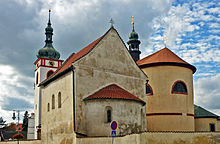
Stará Boleslav is the oldest pilgrimage site in Bohemia.[7] From 2003, the renewed St. Wenceslaus National Pilgrimage in Stará Boleslav takes place here every year on 28 September and is the largest official celebration of St. Wenceslaus Day (Czech Statehood Day). On this occasion, in 2009 Pope Benedict XVI visited Stará Boleslav as the first pope in its history.[8]
Sights
[edit]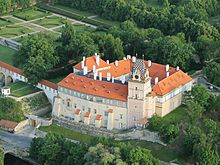
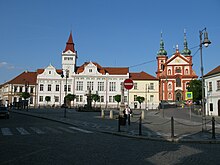
The town is rich in monuments. There are several important objects, protected as national cultural monuments: Church of the Assumption of the Virgin Mary, Church of Saint Wenceslaus and Church of Saint Clement, Brandýs nad Labem Castle, and Palladium of the Bohemian land.[9]
Brandýs nad Labem Castle was originally a medieval Gothic castle, rebuilt into the Renaissance residence in the mid-16th century. The castle is characterized by an exceptionally extensive sgraffito decoration and a park with a preserved Renaissance layout. After Prague Castle, the castle was one of the most important Habsburg residences in the Czech lands. Between 1547 and 1918, it was visited by all the monarchs of the Habsburg dynasty.[10]
The Church of Saint Wenceslaus and the Church of Saint Clement are a pair of important neighbouring Romanesque churches. The area of churches is located in the place where the gord with the old Romanesque Church of Saints Cosmas and Damian stood. The Church of Saint Wenceslaus is a three-nave basilica, founded in 1039 by Duke Bretislav I and consecrated in 1046. At the end of the 11th century, the adjoining Church of Saint Clement was built. It is valuable for its Romanesque frescos from the latter half of the 12th century depicting scenes from St. Clement's life and martyrdom.[3]
The Church of the Assumption of the Virgin Mary is a large early Baroque church, associated with many notable artists. It was built in 1613–1623. It is located on the site of the older building of the Church of the Virgin Mary and Saint George, which was first mentioned around 1098. Due to the Thirty Years' War, the first tower was built only in 1674–1675 and the second, according to the design of Kilian Ignaz Dientzenhofer, in 1750–1760. The main altar was made in the years 1717–1723 according to the design of František Maxmilián Kaňka. The sculptural decoration comes from the workshop of Matthias Braun.[11]
The main altar of the Church of the Assumption of the Virgin Mary contains a Gothic relief of Madonna and Child called Palladium of the Bohemian land. It probably dates from the 1380s and according to legend, its origin is connected with St. Ludmila and St. Wenceslaus. It is among the most valuable movable monuments in the country. In the 17th–20th centuries, many copies were made, located in churches all over the Czech Republic.[12]
A town gate, which is a remnant of medieval fortifications of Stará Boleslav, has been preserved. Other monuments in Stará Boleslav include several notable Baroque buildings: the Chapel of Blessed Podiven from 1738, designed by K. I. Dientzenhofer; the Jesuit college from the second half of the 17th century; the provost's seat built in 1728–1734; and the chapter deanery built in 1710–1712.[7]
Notable people
[edit]- Jan Tesánek (1728–1788), scholar and author of scientific literature
- Karel Šebor (1843–1903), opera composer
- Maria Theresa of Austria (1862–1933), archduchess
- Leopold Salvator of Austria (1863–1931), archduke and Prince of Tuscany
- Bohumil Honzátko (1875–1950), gymnast and long-distance runner
- Antonín Bečvář (1901–1965), astronomer
- Rudolf Kirs (1915–1963), cellist
- David Novotný (born 1969), actor
- David Rikl (born 1971), tennis player
- Oto Biederman (born 1973), serial killer
- Tomáš Votava (born 1974), footballer
- Marek Matějovský (born 1981), footballer
- Ondřej Synek (born 1982), rower, Olympic medalist
- Michaela Uhrová (born 1982), basketball player
- Amálie Hilgertová (born 1997), slalom canoeist
Twin towns – sister cities
[edit]Brandýs nad Labem-Stará Boleslav is twinned with:[13]
 Dunaivtsi, Ukraine
Dunaivtsi, Ukraine Gödöllő, Hungary
Gödöllő, Hungary Montescudaio, Italy
Montescudaio, Italy
Trivia
[edit]The name of municipality is the second longest in the country (after Nová Ves u Nového Města na Moravě) with 32 letters and spaces.[14]
Gallery
[edit]-
Masarykovo Square in Brandýs nad Labem
-
Sv. Václava Square in Stará Boleslav
-
Medieval tower in Stará Boleslav
-
Palladium of the Bohemian land
References
[edit]- ^ "Population of Municipalities – 1 January 2024". Czech Statistical Office. 2024-05-17.
- ^ "Koupání u Proboštských jezer" (in Czech). CzechTourism. Retrieved 2023-05-26.
- ^ a b "Kostel sv. Václava a kostel sv. Klimenta" (in Czech). National Heritage Institute. Retrieved 2023-05-26.
- ^ a b c d e "Historie" (in Czech). Město Brandýs nad Labem-Stará Boleslav. Retrieved 2023-05-26.
- ^ "Historický lexikon obcí České republiky 1869–2011" (in Czech). Czech Statistical Office. 2015-12-21.
- ^ "Population Census 2021: Population by sex". Public Database. Czech Statistical Office. 2021-03-27.
- ^ a b "Poutní místo Stará Boleslav" (in Czech). CzechTourism. Retrieved 2023-05-26.
- ^ "Národní svatováclavská pouť ve Staré Boleslavi" (in Czech). CzechTourism. Retrieved 2023-05-26.
- ^ "Výsledky vyhledávání: Kulturní památky, obec Brandýs nad Labem-Stará Boleslav". Ústřední seznam kulturních památek (in Czech). National Heritage Institute. Retrieved 2024-07-19.
- ^ "Zámek Brandýs nad Labem" (in Czech). National Heritage Institute. Retrieved 2023-05-26.
- ^ "Kostel Nanebevzetí Panny Marie" (in Czech). National Heritage Institute. Retrieved 2023-05-26.
- ^ "Palladium země České neboli Staroboleslavské Palladium" (in Czech). National Heritage Institute. Retrieved 2023-05-26.
- ^ "Partnerská města" (in Czech). Město Brandýs nad Labem-Stará Boleslav. Retrieved 2023-05-26.
- ^ "Zajímavosti názvů obcí v České republice" (in Czech). Czech Statistical Office. Retrieved 2021-01-05.
External links
[edit]


